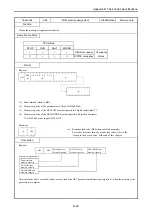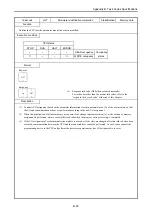
Appendix B Task Codes Specifications
Description
1]
READ occupancy (subcommand H01)
This command is used when the local station is not occupying the CPU if performing tasks such as reading the user
program, monitoring and setting the data memory or the I/O.
2]
WRITE occupancy (subcommand H02)
This command is used when writing the user program if the local station is not WRITE-occupying the CPU. This
command cannot be used when another station is occupying the CPU.
3]
Occupancy mode modification (modification from WRITE occupancy to READ occupancy) (subcommand H05)
Modifies the CPU occupancy mode of the local station to the READ occupancy.
This command cannot be executed when the local station is not occupying the CPU.
When modifying from WRITE occupancy to READ occupancy, the parameter modification completion processing is
performed.
4]
Occupancy mode modification(modification from READ occupancy to WRITE occupancy) (subcommand H06)
Modifies the CPU occupancy mode of the local station to WRITE occupancy.
This command cannot be executed when the local station is not occupying the CPU.
This command cannot be executed when another station is occupying the CPU.
5]
Occupancy cancel (subcommand H00)
Cancels the local station CPU occupancy.
When canceling the WRITE occupancy, the parameter modification completion processing is performed.
Execution conditions in the occupancy status
CPU occupancy status
Function selection (subcommand)
H01
H02 H05 H06 H00
No
occupancy
{
{
×
×
{
Local station is WRITE-occupying
×
{
{
{
{
Another station is WRITE-occupying
×
×
×
×
{
Only the local station is READ-occupying
{
×
{
{
{
Local and other stations are READ-occupying
{
×
{
×
{
Only another station is READ-occupying
{
×
×
×
{
Four other stations are READ-occupying
×
×
×
×
{
From the viewpoint of host A, host A is the local station and host B is the other station.
From the viewpoint of host B, host B is the local station and host A is the other station.
Li
n
k
Host
A
Li
nk
CP
U
A
CP
U B
Host
B
B-13















































